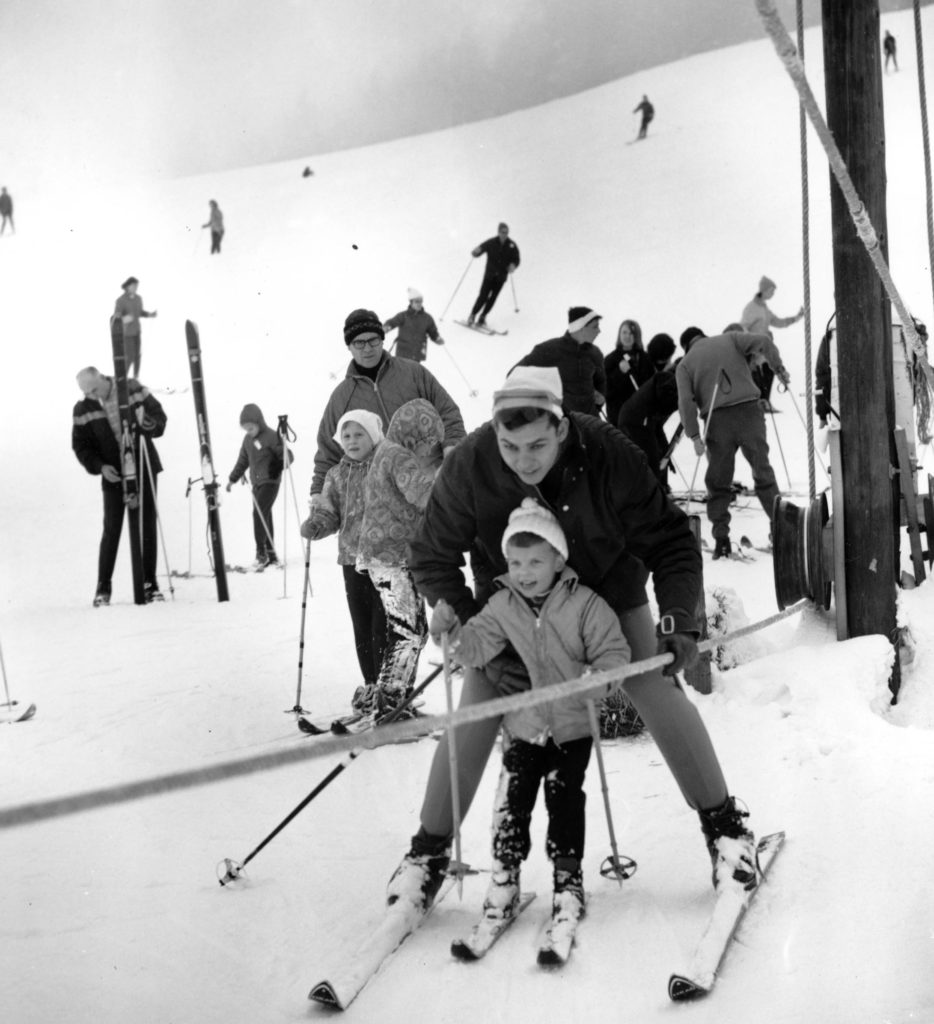Thinking Like a Community
Connecting Our Stories
to Shape Our Future
IRIS Story Archive Coming Together
While the process of organizing the more than 500 oral histories and success stories we’ve gathered has been something of a tedium stress-test, it has also been incredibly energizing to revisit the many examples of collaboration, creativity and just plain grit that they highlight. It has also reminded me of the contributions so many people from this region and beyond have made in building this collection over the past 15 years by interviewing, transcribing, writing, editing and more. We are so grateful for all of the support we have had along the way. It will truly be a regional achievement when IRIS and NCRL “go live” with the Thinking Like a Community archive this November and people can begin accessing the stories and using them to inform and inspire their own success in this place.

Until then we’ll be sharing a few stories from the IRIS journey along with some, such as that by Neal Hedges below, that show how we can work together to learn more about the nature of our non-human neighbors in the region. The recording and transcript of the 2017 group interview that informed this story about the spotted bat capture will be available on the Thinking Like a Community archive this fall.
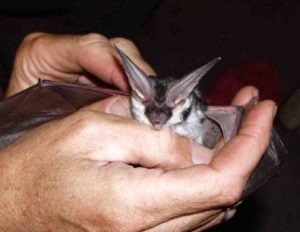
All Ears in Moses Coulee
Sharing Surprise with a Spotted Bat
by Neal Hedges
The spotted bat was flying low through a dry wash near Dutch Henry Falls in Moses Coulee looking for a meal on a warm August night. Guided by echolocation, the bat flew swiftly through the night hunting noctuid moths that feed on coyote tobacco, Nicotiana attenuate, a fragrant annual plant that had bloomed in the coulee following a series of channel-scouring floods the previous winter.
Two hundred yards to the east, three people listened to the faint insect-like clicks, taking notes on the number of calls and the direction of the bat’s travel. 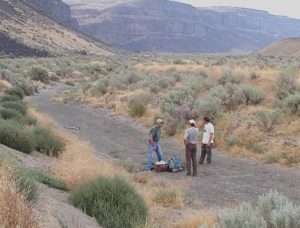 Later that night they would report their findings to a group of 40 volunteers from The Nature Conservancy (TNC) who were here to gather information about the distribution of the spotted bat that was only recently discovered roosting in the towering basalt cliffs of the Coulee. When I heard the volunteer’s report about the low-flying bat, I knew we had a rare opportunity to capture a spotted bat, something few people had done anywhere in the western US.
Later that night they would report their findings to a group of 40 volunteers from The Nature Conservancy (TNC) who were here to gather information about the distribution of the spotted bat that was only recently discovered roosting in the towering basalt cliffs of the Coulee. When I heard the volunteer’s report about the low-flying bat, I knew we had a rare opportunity to capture a spotted bat, something few people had done anywhere in the western US.
Our group that night included TNC’s Moses Coulee Program managers, Chuck and Nancy Warner, their assistant Susan Pinkus, biologists from the Bureau of Land Management, and a number of TNC members from Seattle who had traveled across the mountains to North Central Washington to help with this unique citizen science project.
Over the past few years, biologists from state and federal agencies had been trapping bats in the coulee to find out what species lived here. Bat research was still in its infancy in Washington and every night spent trapping bats added new information about the diversity, distribution, and abundance of this little known group of animals. So far we had trapped 13 of Washington’s 15 species and knew that a fourteenth, the spotted bat, was here because we could hear it flying overhead on many nights.
Spotted bats are the only bats in Washington whose echolocation calls can be heard by humans. Echolocation is how bats navigate and find their insect prey in the dead of night. It is so sophisticated that it can be described as seeing with sound. All North American bats use echolocation but at frequencies far above the threshold of human hearing. If you are fortunate to have an electronic gadget called a bat-detector, the night becomes filled with the chirps, smacks, buzzes, and ticks of flying and feeding bats.
Before 1992, no one knew that spotted bats lived in Washington. This puzzled Canadian bat researcher Mike Sarell who had been studying spotted bats in British Columbia 100 miles north of here. Mike knew that spotted bats roosted in tall cliffs in the arid interior of western North America and thought if they were found in British Columbia and in Oregon, they had to live in Washington. Funded by a grant from the Washington Department of Fish and Wildlife, Mike began finding spotted bats in suitable habitats from Oroville to Wenatchee. He hit the bat jackpot in Moses Coulee finding more spotted bats than anywhere he’d searched.
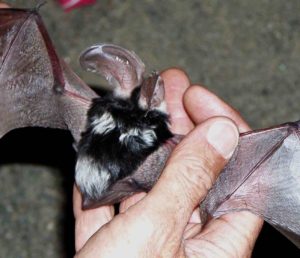 Kent Woodruff, a Forest Service biologist, had accidentally captured the first spotted bat in Washington in 2002 while trapping other species of bats in the upper Methow Valley. Catching a spotted bat anywhere in the Western United States and Canada is rare because these bats fly high overhead feeding on night-flying moths, and few biologists have traps that can be lifted high enough to intercept them in flight. But spotted bats have a habit of returning to the same feeding areas where they’ve had hunting success, a behavior call trap-lining. If the low flying bats in Moses Coulee followed this behavior, we had a rare opportunity to capture one of these elusive creatures.
Kent Woodruff, a Forest Service biologist, had accidentally captured the first spotted bat in Washington in 2002 while trapping other species of bats in the upper Methow Valley. Catching a spotted bat anywhere in the Western United States and Canada is rare because these bats fly high overhead feeding on night-flying moths, and few biologists have traps that can be lifted high enough to intercept them in flight. But spotted bats have a habit of returning to the same feeding areas where they’ve had hunting success, a behavior call trap-lining. If the low flying bats in Moses Coulee followed this behavior, we had a rare opportunity to capture one of these elusive creatures.
On a warm summer evening in mid August we drove the dusty gravel road toward Jameson Lake and pulled over near where the volunteers heard low-flying bats. Our crew included John Musser, Erik Ellis and me from the BLM and Chuck and Nancy Warner and Susan Pinkus from TNC. After gathering our gear for the night, we hiked cross country through sagebrush toward the sandy wash. This was the hour that rattlesnakes become active so we scanned the path ahead to avoid startling one of these shy reptiles.
“We were optimistic – we figured if there were any bats flying down this wash they could run into one of our nets.” – Neal Hedges
Our first task was to set out a series of five mist nets, the standard bat trap that looks like a volley ball net made with ultra fine thread. John, Erik, and I stretched four nets low across the wash and raised a fifth net above the rest to heighten our reach. After the nets were in place we furled them to avoid catching swallows that still zoomed through the coulee and sat down to await the first bats of the evening. At twilight, western small-footed myotis, the most common bat in the coulee, and western pipistrelles began flitting above us in pursuit of tiny insects. It was time to unfurl the nets and await the arrival of spotted bats.
“The net that actually caught the bat was the northern one that was in the lower part of the draw.” – Chuck Warner
After opening the nets, we moved away from the wash to begin our nighttime vigil. Off to the east a coyote howled and white-throated swifts still chattered at the top of the cliffs. As twilight faded into night, we captured our first bat, a western small-footed myotis that was now enduring the humiliation of being examined and measured. We hadn’t heard the tick of spotted bats and were settling into the bat-catching routine of checking the nets every five minutes to see what we caught. Most bats begin chewing their way out of the netting if left too long and by late summer our nets were tattered with rips and holes made by bats freeing themselves from the unexpected entanglement.
“I remember walking around as they were opening up the nets and being amazed by the size and fragrance of the Indian tobacco plants blooming that night.” – Nancy Warner
As we examined the little myotis, Susan took her turn checking the northern nets. We hadn’t heard a spotted bat yet that night and were startled to hear Susan yell “We’ve got one!” “You’re kidding!” I said, hesitating for a second, but when Susan said again “Yes, we’ve got one!” I tossed the myotis unceremoniously into the air and ran toward the net where we found a bat like no other we’d seen. It had long pale wings, huge pink ears, a jet black back with three snow-white spots, and a chalk-white belly. This was the first spotted bat deliberately caught in Washington but before we could celebrate we had to secure and record our remarkable catch.
“This bat really did look at the people around it more than I’ve seen a lot of other bats.” – Neal Hedges
Susan said later that her first thought had been –don’t do anything to lose this bat! She might have heard that spotted bats do not tangle as badly as most bats and had been seen flying off after hitting a net.
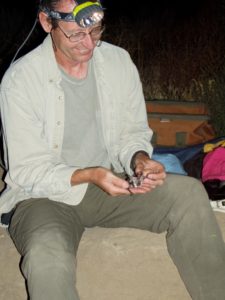
“I’ve seen some people with their newborn children and this was similar.” – John Musser
I quickly but gently held the bat and began to disentangle it from the mesh. Once free from the net I held it for all of us to see. What several of us remembered later was the bat turning its little head to look at each of us huddled around. Its mouth was open but it made no sound and did not struggle or bite the way many bats do. It felt like we were in the presence of a little alien being.
I remember the shock of seeing the big ears and the spots in the net and I couldn’t believe it.” – Susan Pinkus
When we finally settled down to examine the bat, we discovered it was a juvenile female with a wingspan of 15 inches. She was heavier than many species we’d captured but of delicate build. After thorough examination and photos, we released the little female, into the night.
When the excitement of the catch began to settle down and we prepared to gather our gear, we noticed a huge coyote tobacco plant covered with moths within a few feet of the net. We will never know if this was the bait that attracted the young bat, but we like to think it made the difference for us that memorable night in Moses Coulee.
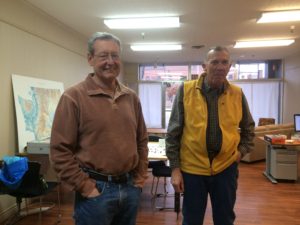
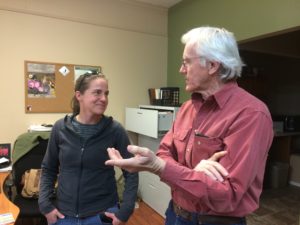
“Every time I hear a spotted bat I try to share the experience with others, to help them connect the sound with the animal – the only bat we can actually hear in our part of the country.” – Erik Ellis
Postscript. Two years later near this same location, a team of graduate students who were using radio telemetry to study the behavior of bats in Moses Coulee, captured a second spotted bat. They let her go without attaching a transmitter.
Features From the Archive
Watch the video, Homegrown Ski Areas of NCW, the 2008 Gathering Our Voice project, to learn more about how community is created.
